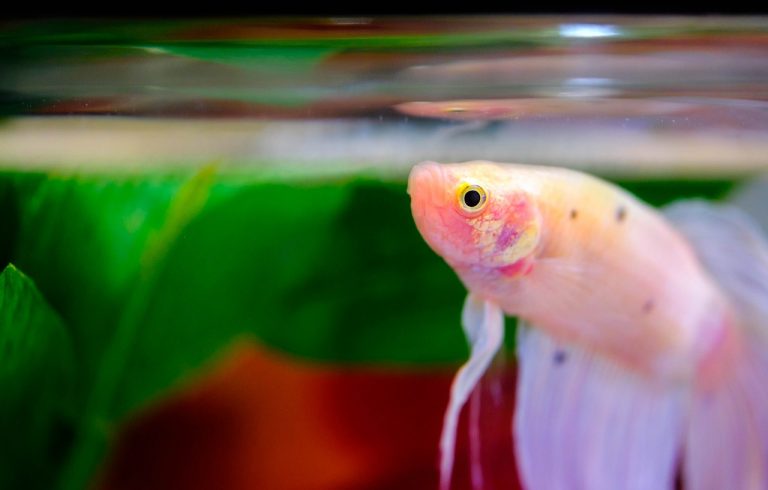Saltwater fish tanks are one of the most popular types of aquariums. They have a more natural look and feel than freshwater tanks, which some people prefer. However, setting up a saltwater tank is not an easy process – many beginners struggle with it due to a lack of knowledge about how to set up for keeping fish in such an environment. In this article, we will discuss all you need to know before getting started on your first saltwater aquarium!
Some images and products shown in this article are affiliate links, we may earn a small commission, we hope you find the information useful.
Equipment Needed to Set Up a Saltwater Aquarium
- Good Size Fish Tank, the tank size should be as big as you can afford or have room for, a small tank is not recommended for saltwater set up, I would recommend a minimum of 100Ltrs when choosing a saltwater fish tank.
- Water Filter, make sure the filter is large enough to filter the volume of water within the tank, this will ensure the water remains clean and safe for the fish plus reduce ongoing tank maintenance required.
- Heater, heating a saltwater aquarium is very important the temperature should be 72 – 78 degrees for most saltwater fish.
- Lighting, replicating a natural habitat for fish is important for the fish adding lighting will replicate sunlight that fish would have naturally, lighting should be turned on during the day for up to 8 hours and then switched off to replicate night time, a good type of lighting is LED lighting which has white and blue LED’s, white light for replicating the sun and blue light replicating the moon, ensure the lighting is suitable for saltwater tanks.
- Wave Pump, saltwater fish’s natural habitat is in the ocean where there are large waves and plenty of water movement, this needs to be created within a saltwater aquarium set up, a fish tank wave-making pump will create plenty of movement to your saltwater aquarium.
- Protein Skimmer, if your saltwater setup is large then a protein skimmer can be used to help keep the tank water much cleaner, with a smaller aquarium set up simple regular 20% water changes will be perfectly fine for water maintenance.
Equipment for Saltwater Aquariums
Aquarium
Last update on 2024-07-25 / Affiliate links / Images from Amazon Product Advertising API
Water Filter
Last update on 2024-07-25 / Affiliate links / Images from Amazon Product Advertising API
Heater
Last update on 2024-07-25 / Affiliate links / Images from Amazon Product Advertising API
Lighting
adding depth and dimension to the aquarium. 24 hours each day without extra wear and tear
Last update on 2024-07-25 / Affiliate links / Images from Amazon Product Advertising API
Wave Pump
Last update on 2024-07-25 / Affiliate links / Images from Amazon Product Advertising API
Protein Skimmer
Last update on 2024-07-25 / Affiliate links / Images from Amazon Product Advertising API
Setting Up A Saltwater Aquarium
- Ensure the aquarium tank is located in a position that is not in direct sunlight and is on a sturdy base or stand, make sure the tank is perfectly level.
- The equipment can be positioned in the tank, this will depend on your chosen equipment type but ensure all elements are included as shown in the equipment section above with a protein skimmer being optional, simply remember these four points: Lights, Heating, Filtration, Water Movement. (Do not plug in any equipment to the mains power at this stage).
- Add Sand to the bottom of the aquarium, this is optional but for a more pleasing set up I would recommend adding sand to the bottom of the tank.
- Add Rocks or coral depending on your chosen set up create an aquascape that you will enjoy looking at, make sure the rocks or corals are suitable don’t just put rocks out of your garden in the tank! If adding coral to the tank make sure they are not too close to each other leave a small gap between them, corals can be attached to rocks for a pleasing look, an easy way to attach corals to rocks is simply to use superglue and stick them on sounds weird I know but many aqua-scapers use this method.
- The next step is to add water to your tank, it is recommended that the water is dechlorinated using a 3 stage filter which ensures the water is pure, if you cannot do this then simply use tap water with a dechlorination fluid to your water in the same way as a freshwater set up. Adding salt to your water is very easy, simply follow the guidelines on your chosen salt brand with the correct quantities, make sure it is fully dissolved and mixed into the water in your bucket before pouring it into the tank, the salinity of the mix wants to be between 1.023 to 1.025, the water will look very cloudy at first don’t worry this is normal.
- Turn on all your equipment and start your nitrogen cycle in the same way you would with a freshwater setup, make sure the cycle is complete before introducing fish to your aquarium.
Our Choice Sea Salt For Saltwater Aquarium
Last update on 2024-07-25 / Affiliate links / Images from Amazon Product Advertising API
Looking After Saltwater Fish
The equipment and setup procedures shown above setting up a saltwater fish tank are very similar to setting up a freshwater tank, the important differences are water temperature, water movement, and saltwater.
Saltwater fish can be very expensive so make sure regular water checks and regular 20% water changes are carried out. Ensure the correct amount of salt is added to any water added to the aquarium.
Always talk to your fish supplier about the fish you purchase for your aquarium as some types of fish may require a special setup, if you are a beginner try to choose a hardy variety of fish to begin keeping saltwater fish.
Best Saltwater Fish for Beginners
If you are new to keeping saltwater fish then starting with easy-to-keep saltwater fish will help you to get into the hobby. Beginning with hardy fish first will help you to learn the basics of keeping fish in an aquarium, hardy fish are more susceptible to water variations, slight temperature changes, and tank conditions without becoming stressed or poorly.
Keeping Fish Top 5 Saltwater Fish Choices
Blue Tang (Palette Surgeonfish)
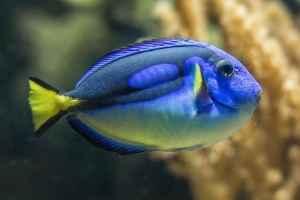
This fish is a great choice for a saltwater aquarium they are not aggressive fish and look beautiful within the tank, they are also fun for younger children as they will recognise them from the film Finding Nemo as they look like dory!
Ocellaris Clownfish (Amphiprion Ocellaris)

The clownfish is one of the most popular saltwater aquarium fish and was the star fish in the film Nemo, they love to live in aquariums and are really fun to watch and keep, they can grow as big as 4 inches giving beautiful colour and vibrancy to an aquarium.
Banggai Cardinalfish (Pterapogon Kauderni)
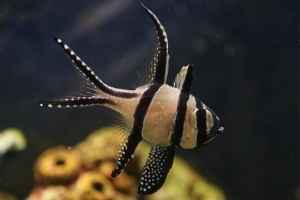
A stunning fish for a saltwater aquarium they are fairly hardy and also work well in numbers, it is recommended that your tank setup should be at least 120Ltrs as they can grow up to 4 inches in diameter, this fish will actively breed in an aquarium so bear that in mind when purchasing.
Foxface Rabbitfish (Siganus Vulpinus)
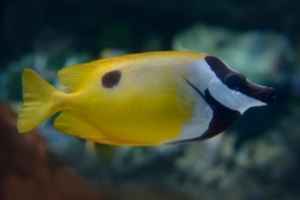
This fish is only suitable for large aquariums 220Ltrs plus, this fish can grow up to 10 inches, they are a great aquarium fish as they spend most of their time cleaning algae within the saltwater aquarium, beautiful to look at and very bright colours, the Foxface Rabbitfish is a peaceful fish and gets on well with other fish. An important point about this fish is it has built-in protection so as not to be eaten by larger fish in the wild with venomous spines, so be very careful not to handle it with bare hands as they can be quite painful.
Coral Beauty (Centropyge Bispinosa)
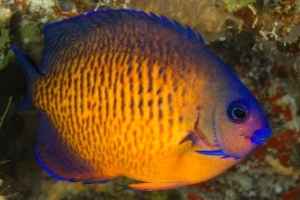
Again best suited to a larger aquarium they are a very peaceful fish and have a variety of colours, it is a hardy fish and will be easy to keep in most large saltwater aquariums.
Frequently Asked Questions
The minimum size aquarium for saltwater fish would be a recommended size of 120 Litres, anything smaller would be more difficult to maintain, aquariums above this size would be perfect for beginners, an ideal size aquarium in the home would be 300 Litres and above if you have a large enough room.
The best temperature setting for saltwater tropical fish is 78 to 82 degrees Fahrenheit, if keeping a tropical reef aquarium it would be better to maintain a temperature of 75 to 78 degrees Fahrenheit.
There is no exact science to this but is recommended that you keep 1 fish per 4 litres of water, so in a 120 Litre aquarium 30 fish would be the maximum number of fish for the tank, this is based on fish that grow up to approximately 2 inches, so if keeping large fish in the tank that number would be greatly reduced if keeping small shoaling fish that number could be increased.
The initial cost of setting up a saltwater aquarium is more expensive than keeping freshwater fish, this is due to fish generally being more expensive plus tank decorations being more costly such as corals, rockwork, and aquascapes.
No, do not put freshwater fish into a saltwater aquarium as they will not survive, always ask your pet store for advice about the fish you are buying and let them know you are keeping a saltwater aquarium.
We hope you found this article “How to set up a saltwater fish tank basic setup for beginners” useful for starting out keeping saltwater fish in an aquarium.








